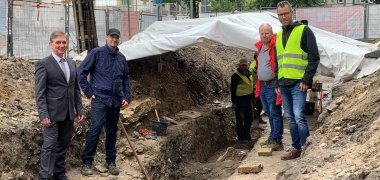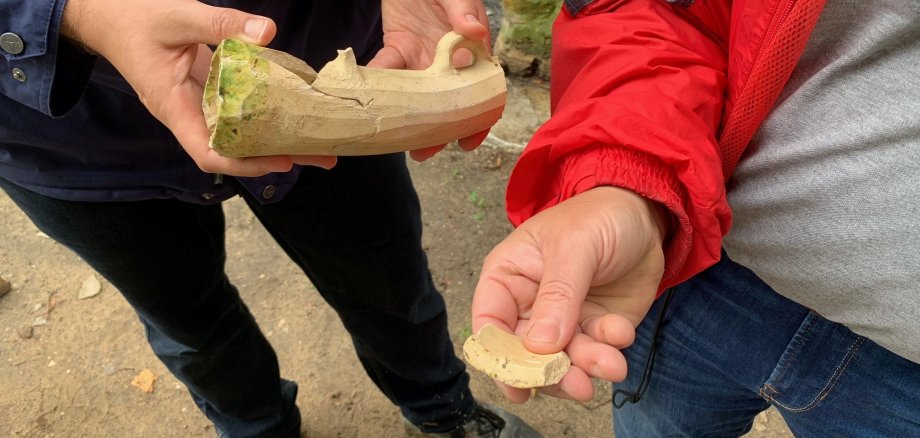Church square
Pilgrim's horn, funerals and a bridal portal
Now the Landschaftsverband Westfalen-Lippe, as the agency responsible for the preservation of archaeological monuments, has presented the first results of the urban archaeology.
Due to the archaeological work so far, the originally planned construction work is currently seven weeks behind schedule. "Due to these delays, the originally envisaged completion by April 2024 is unrealistic. However, we have considered such a scenario from the beginning and have always communicated it openly," emphasises Horst Schenkel, head of the technical department of the city of Beckum.
The area around St. Stephen's Church was used as a cemetery by the people of Beckum for several centuries. This is confirmed by the latest finds of the team around excavation leader Dr. Joachim Meffert, who has been carrying out excavations around the Provost Church for several weeks.

"More than 60 burials have been found so far, mainly from the 16th to 18th centuries," reports Dr Joachim Meffert. The archaeologists' assumption that the churchyard had been continuously used and expanded since the Middle Ages has also been further consolidated. "This is shown by foundations that lay beneath the burials and were disturbed when the cemetery was expanded." A Christian burial at that time followed a fixed ritual: the dead were oriented in an east-west direction - just like the church building - laid on so-called boards for the dead and then buried without a coffin. Other citizens of Beckum's urban society, however, also received higher-quality wooden or stone coffins: Analogous to the medieval graves in Propsteigasse, which were discovered in 2022, another stone box grave was also uncovered.
"Nevertheless, by no means all the dead found their final resting place in the churchyard or in the church: among others, suicides, the executed, members of "dishonest" professions, people of other faiths and adulterers were often denied this right," Joachim Meffert emphasises. Perhaps a burial found outside the Beckum church wall also had such a background.
In addition to various individual finds, such as a large gravestone from the 15th century, the excavation team also discovered a fragment of a so-called pilgrim's horn. "Such clay blowing horns are associated with pilgrimages in Aachen, among other places. There they were carried along on the procession and then brought back home. The object dates to the 14th to 16th century," says Dr Andreas Wunschel from the LWL Archaeology for Westphalia, classifying the find.
On the north side of the Gothic provost church, remains of the former bridal portal also came to light. The name refers to the medieval custom of performing marriages in front of the church portal and then entering for mass. The previous finds will certainly not be the last.
"No decision has yet been made on how to deal with very special finds, but the bones from the area of the former cemetery will in any case be left to the parish of St. Stephanus for reburial," emphasises Dr. Christian Hofbauer, head of the department of the city of Beckum.
Further information on the excavation results is planned in the context of the excavation work - the City Museum will offer a programme for children after the summer holidays to explain the tasks of urban archaeology to the youngest visitors. After the excavation work has been completed, guided tours will also be offered for interested visitors. In addition, the City Museum is planning a lecture event with Dr. Joachim Meffert in autumn. The dates will be announced later.

